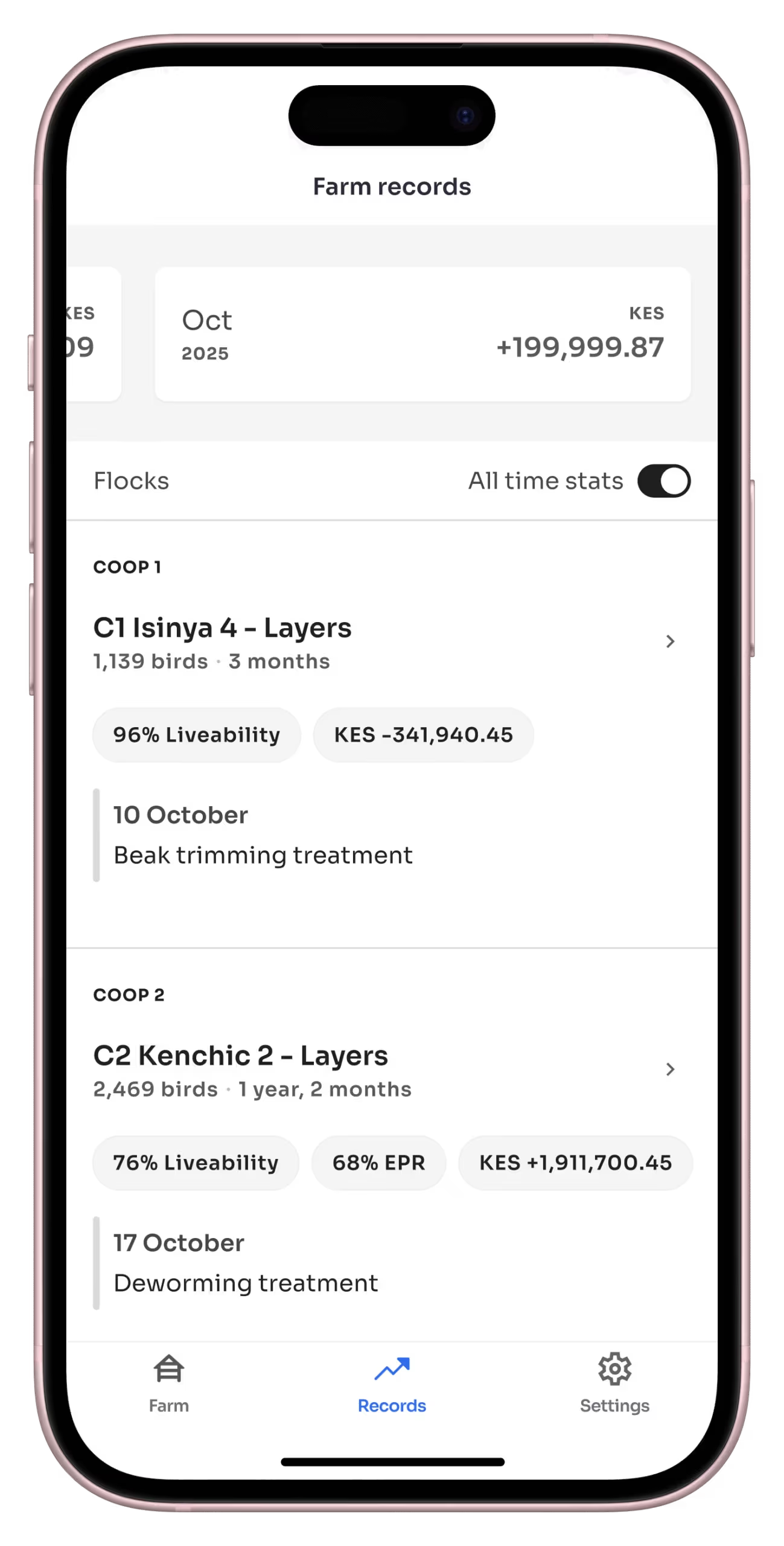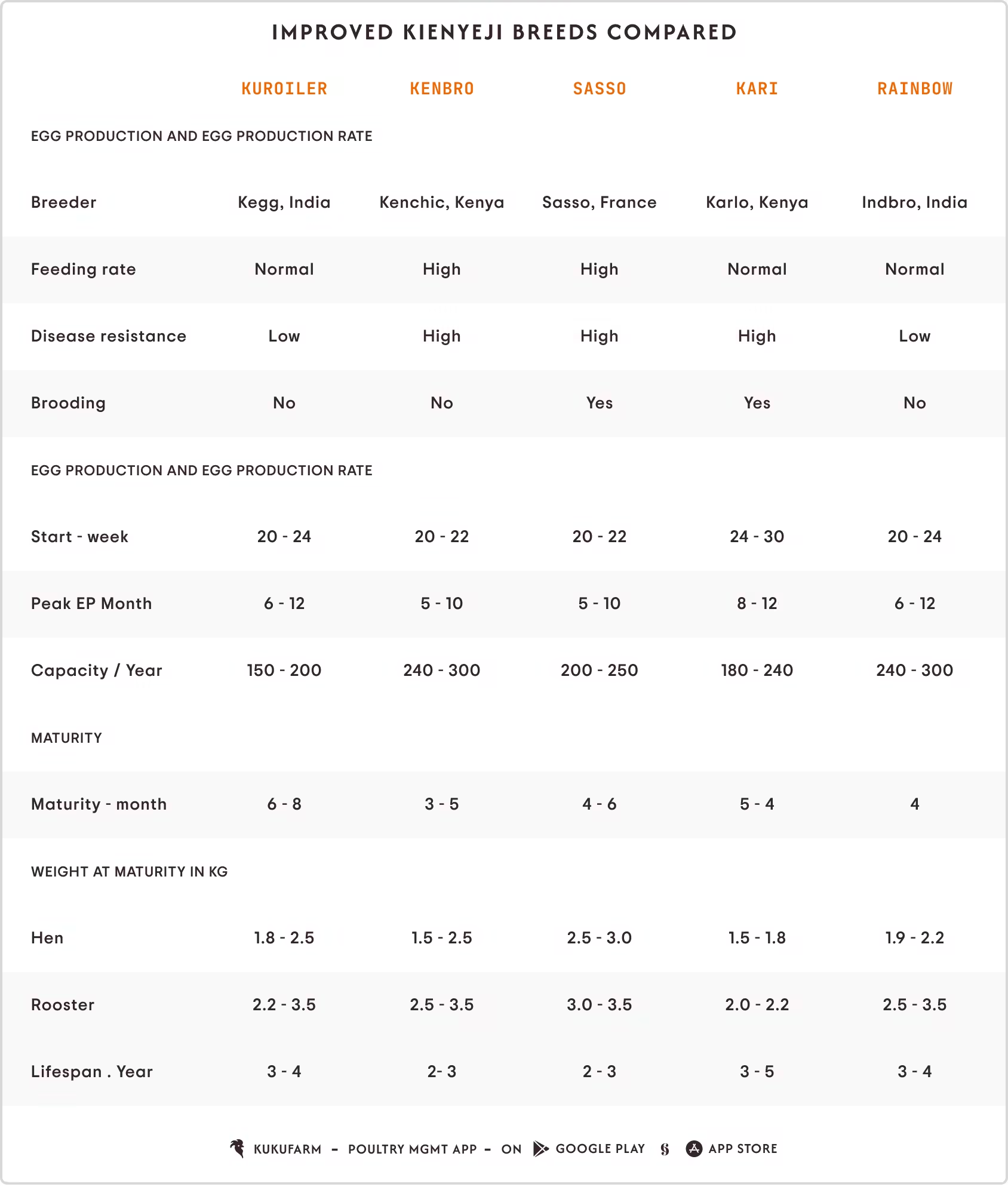In recent years, improved kienyeji breeds have transformed poultry farming. As a result, farmers like you have been able to achieve increased flock performance and yield.
However, how well do you know these improved kienyeji breeds? Do you know how they compare? Is any one of them any better?
Improved kienyeji breeds comparison factors:
- Feeding rate
- Growth rate
- Disease resistance
- Brooding
- Egg production rate
- Weight gain
- Life expectancy
In this article we compare improved kienyeji breeds, allowing you to make an informed farming decision. Ultimately, understanding these differences empowers you to select the best breeds that align with your specific needs and farming goals.
You may also be interested in:
- Comparison of pure VS improved kienyeji
- How to guarantee poultry farming success in Kenya
- 8 Hidden benefits of record keeping in poultry farming

Improved kienyeji breeds
There are 5 improved kienyeji breeds in the East African region. These are:
- Kuroiler
- Kenbro
- Sasso
- Kari
- Rainbow
We refer to these breeds as improved kienyeji because they result from cross-breeding pure kienyeji with other poultry breeds. Furthermore, breeders developed them to combine the disease resistance and resilience of kienyeji chickens with the high productivity of other breeds.

Your improved kienyeji breeds come from India, France, and Kenya, as shown in the chart above. Specifically, Kuroiler and Rainbow are developed in India, Sasso originates from France, and Kari and Kenbrow are bred in Kenya.
However, we don’t know much about the specific poultry breeds that have been interbred with pure kienyeji to create these improved breeds. Additionally, breeders have been tight-lipped about breed performance benchmarks.
In our opinion, it would simply things for farmers if all poultry breeders and suppliers published breed performance.
We know even less of pure kienyeji. However, in a study, we found pure kienyeji can have an egg production rate of upto 50%. That is 150 – 180 eggs per year. We’ve also written about the unique characteristics of kienyeji chicken.
Improved kienyeji breeds compared
In this section, we compare improved kienyeji poultry breeds. We use factors such as feeding rate, disease resistance, brooding, egg production, and maturity for this comparison. To gather this information, we have referenced several online sources.
Feeding rate: To begin with, Kuroiler, Kari and Rainbow are normal feeder. In contrast, Kenbro and Sasso are high feeders. However, these heavy feeders mature early than the normal feeders, as you can see below.
Disease resistance: This is definitely an important comparison factor. While Kenbro, Sasso and Kari have high resistance, Kuroiler and Rainbow have low resistance.

Egg production: Apart from Kari improved kienyeji which starts egg production around weeks 24 – 30, the rest can start as early as week 20. However, Kari has a longer egg production period. In contrast, Kuroiler has the lowest egg production rate while Kenbro and Rainbow have the highest.
How to choose an improved kienyeji breed for farming
Below are 3 pointers that you can consider if you’re trying to choose a poultry breed.
Obtain actual breed benchmarks
We cannot emphasize this enough! Always get actual breed performance data before purchasing a breed or flock.
Breed performance benchmarks will help you make an informed decision, which is essential for data-driven poultry farming. Without this information, you’ll be left guessing, and in our opinion, that’s a recipe for disaster.
Moreover, if you’re already farming these breeds, get into the practice of keeping poultry records e.g. using Kukufarm.

Flock sourcing
For best outcomes, obtain your improved kienyeji flock from original breeders. Unfortunately, there are countless stories of farmers who have been sold poor, mixed and impure breeds by “middle men.”
Educate yourself on poultry management
Improved kienyeji poultry farming can be a joy for you, and quite profitable. However, as with any type of farming, taking the time to be prepared will be to your benefit.
Additionally, we recommend that you link with local farmers in your area and learn about poultry management. Such training will save you a lot of heartache later on. Furthermore, it will also do you good to get acquainted with challenges in poultry farming.

Moreover, follow well know farmers on social media and keep tabs with flock management practices for best outcomes. Moreover, another important factor you will want to look into is what poultry housing system would be suitable for your poultry farming operation.

